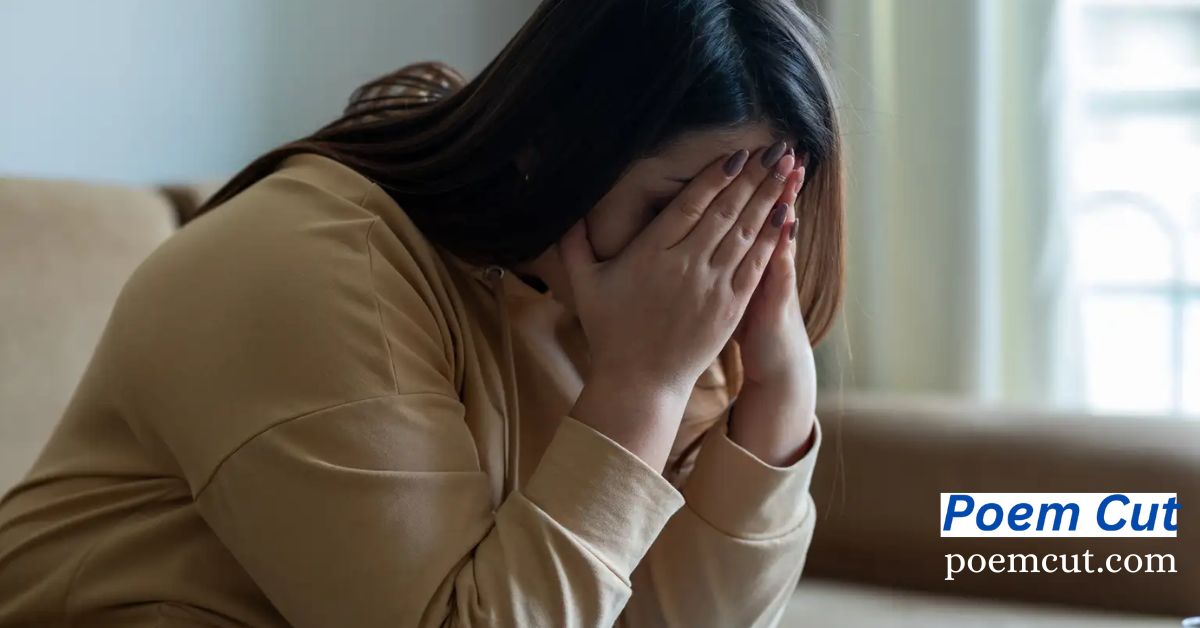Sadness is one of the most raw, powerful emotions humans can experience. When words fail, a sad poem speaks. It captures what lingers in our chests—those heavy silences, the heartbreaks, the longing, the grief we carry quietly. This article is a deep dive into the world of sad poetry: how it expresses the pain of loss, helps us process emotional burdens, and guides us slowly toward healing.
Whether you’re reading to reflect or writing to release, this exploration will offer comfort, understanding, and poetic beauty.
Why Sad Poems Matter So Deeply

Sad poems aren’t written just to dwell in pain—they help give it shape. In a world that often rushes through emotions or dismisses vulnerability, a sad poem gives grief a voice. It slows us down. It says, “Yes, this hurts—and you’re not alone.”
Key reasons sad poems resonate:
- They validate emotions many are too afraid to express out loud.
- They build a bridge between personal experience and universal feeling.
- They offer catharsis—a healthy, creative way to let emotions out.
A reader may not have written the poem, but they feel it deeply. And sometimes, that’s enough to start healing.
The Essence of Sad Love Poems
Sad love poems often linger around one theme: loss—the loss of a person, the loss of trust, or the fading of a once-bright connection. The language in these poems is delicate, often reflective, sometimes aching.
When the Heart Breaks Poetry from the Edge of Love
Heartbreak doesn’t speak in complete sentences. Poets take those scattered feelings and give them structure—without losing their messiness.
How sad poems portray a broken heart:
- Through fragmented phrasing or unfinished thoughts
- By showing emotional contradiction (love and resentment, longing and anger)
- With metaphors of physical pain: burning lungs, shattered mirrors, empty arms
Original Poem – “Where You Left Me”
You left me in a room of things we never said,
With shadows dancing in your shape instead.
My voice broke first, then the air, then the clock—
And still, I wait at a door you never knock.
Sad poems offer more than drama—they carry truth. And truth, even when painful, heals in time.
Tearful Nights Poetry Written in Darkness
There’s something about nighttime sadness that hits harder. The distractions fade. The world slows down. That’s when the thoughts come creeping in.
A sad poem written at night often captures:
- Sleeplessness: The mind replays memories again and again.
- Solitude: There’s no one to distract or soothe.
- Reflection: The mind turns inward, often spiraling deeper.
Poem – “Another Night Without You”
I count the stars like unsent letters,
Folded in the crease of my chest.
Every hour without your name
Is a chapter I try to forget.
Tearful nights lead to some of the most powerful and intimate verses in poetry. They’re soaked in vulnerability—and that makes them timeless.
Emotional Burdens The Weight of Feeling Too Much
Not all pain comes from romantic heartbreak. Some of it comes from carrying emotional burdens too heavy to hold. Sad poems often capture this invisible weight.
Poetic themes that reflect emotional burdens:
- Childhood trauma and unresolved grief
- Guilt over something that can’t be undone
- The pressure to stay strong for others
- Feeling misunderstood, even by oneself
Poem Excerpt
There’s a silence stitched into my smile / And a storm behind my spine / I’ve been holding skies from falling / Just so others see the shine.
Poetry makes emotional luggage visible. Once seen, it’s easier to start unpacking it.
Letting the Heart Out The Power of Emotional Release
Writing a sad poem is more than self-expression. It’s a form of emotional release—a way to get the heaviness out of your chest and onto the page.
Why writing sad poetry is healing:
- It forces you to name what you’re feeling
- It slows down racing thoughts into lines and stanzas
- It creates distance between you and the pain
- It allows you to connect with others through shared feeling
Original Poem – “Let Me Break in Words”
I can’t cry aloud, but I can write / Let these vowels carry my fight / Let this ink be bruises turned blue / And each line a wound I finally knew.
When emotions are too complex for conversation, a sad poem lets you bleed safely—without judgment, without fear.
Self-Destructive Emotions in Poetry Facing the Darkness

Sometimes sad poems explore the darker side of sorrow—self-destructive emotions. These aren’t just sad; they teeter on hopelessness, self-blame, or emotional numbness.
Themes to watch for in this style of poetry:
- Internalized shame
- Suicidal ideation (often veiled in metaphor)
- Emotional isolation or withdrawal
- Feelings of worthlessness
Poem Fragment:
I stood by the edge, not to jump—but to understand why the wind calls louder than people do.
Important: Poets often use these themes to explore—not glorify—emotional pain. The goal is awareness, not encouragement.
Sad poems like this must be read carefully. They expose the raw underside of being human—and sometimes, they’re the first step toward asking for help.
Real Stories Personal Experience in Sad Poetry
Not all poems come from imagination. Many come from firsthand experience—a breakup, a death, a betrayal, a moment of emotional collapse.
When a poet writes from their own life:
- The details feel specific, not generic
- The emotion is grounded in truth
- Readers feel like they’ve lived through the poem too
Mini Case Study – “The Year My Father Died”
A grieving daughter writes a poem describing her father’s cologne lingering on his coat in the hallway. The image is simple—but it’s unforgettable. That’s the power of real experience in verse.
If you want to write your own sad poem, begin here: what moment still stings? Write from that scar, not from what you think “should” be poetic.
Healing and Moving Forward Through Poetry
Sad poems don’t have to end in despair. Many chart a journey—from sorrow to survival, from heartbreak to hope. These are the poems that remind us healing is possible.
Ways sad poetry supports healing:
- Encourages emotional honesty
- Allows self-reflection
- Connects people through shared loss
- Inspires courage through words
Poem – “A New Dawn After You”
I packed your silence in a box,
And mailed it to the past.
This morning, I wore peace like perfume,
And smiled without asking why.
Writing sad poetry is not staying stuck—it’s building a way out, one line at a time.
The Shared Human Experience of Sadness
Even if you’ve never experienced the exact sorrow someone else describes in a poem, chances are—you still understand it. That’s because sadness is part of the shared human experience.
What makes sad poetry universal:
- Everyone has known loss in some form
- We all carry memories we don’t talk about
- Sad poems use emotions we’ve all felt: longing, grief, disappointment, hope
Quote:
“Poetry is the record of the best and happiest moments of the happiest and best minds. Yet, it is born of sadness.” – Percy Bysshe Shelley
In truth, a sad poem helps us feel less alone. That’s reason enough to keep reading—and writing—them.
How to Write Your Own Sad Poem
Not sure where to start? Here’s a step-by-step guide to writing your own emotionally rich sad poem:
Step 1 Choose a memory or emotion
Think of a time you felt loss, longing, or deep sorrow.
Step 2 Select your form
Free verse offers flexibility. Try short stanzas to create space between heavy thoughts.
Step 3 Use concrete imagery
Instead of “I felt sad,” say: “The photo frame cracked when I touched it.”
Step 4 Avoid clichés
Skip tired phrases like “broken heart.” Use original language drawn from your own experience.
Step 5 Read it out loud
Does it sound honest? If not, keep revising until it does.
Curated Collection: Original Sad Poems

Here are a few original sad poems to stir the soul and offer poetic company:
“After You”
My voice echoes in a hallway full of ‘should have saids.’
I water your favorite plant with tears and time,
But it doesn’t bloom anymore.
“Glass House”
I built a home from the promises you made—
Glass walls and fragile doors.
Now every lie is a crack I tape,
And every sigh is a storm inside.
“Luggage”
I packed my grief in an overnight bag
And carried it through airports of small talk.
No one asked what it weighed.
No one saw me drag it.
Conclusion
In a world that often rushes past our pain, a sad poem invites us to stop and feel. It’s not weakness to write about heartbreak, emotional burdens, or longing—it’s strength. Through sadness, we remember what matters. Through poetry, we remember we’re not alone.
Whether you’re a reader seeking comfort or a writer trying to cope, know this: your sadness deserves space. And sometimes, a poem is the best room for it.








